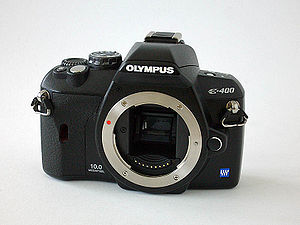- Olympus E-400
-
Olympus E-400 
Type Digital single-lens reflex Sensor 17.3 x 13.0 mm Four Thirds System RGB CCD sensor
2x FOV cropMaximum resolution 3648 x 2736 (10 effective Megapixels) Lens Interchangeable Four Thirds mount Flash Built in Pop-up, Guide number 10 m at ISO 100, hotshoe Shutter speed range 60–1/4000 s Exposure metering TTL open-aperture
49-zone multi-pattern
Range: 1 to 20 EV (50 mm F2, ISO 100)Exposure modes Auto
Program automatic
Aperture priority
Shutter priority
Manual
Scene modesMetering modes Digital ESP
Centre weighted
Spot
Highlight based Spot
Shadow based SpotFocus areas 3 points TTL Phase Diff Focus modes Single AF ( S-AF )
Continuous AF ( C-AF )
Manual Focus ( MF )
S-AF + MF
C-AF + MFContinuous shooting 3 frame/s up to 10 frames (approx.) in HQ JPEG mode
3 frame/s up to 5 frames (RAW)Viewfinder Optical 0.92x Pentaprism ASA/ISO range ISO 100–1600 in 1/3 steps
Noise warning for > ISO 800Custom WB 7 / +7 steps in each R-B / G-M axis Rear LCD monitor 6.4 cm / 2.5″ TFT LCD, 215,000 pixels Storage Compact Flash (Type I and II), xD Picture card Battery Lithium-Ion rechargeable Weight 375 g (body only) The Olympus E-400 is a digital single-lens reflex camera launched by Olympus on 14 September 2006, using the Four Thirds System lens mount standard.[1]. This 10 megapixel camera could be compared to other DSLRs unveiled during the summer of 2006 with comparable pixel count and price range: the Sony α 100, the Nikon D80, the Canon EOS 400D and the Pentax K10D.
Features
The E-400 is notable for its small size, omitting the hand grip and exploiting the smaller sensor. It weighs only 375g and approaches manual focus film SLRs sizes, reminiscent of the Olympus OM system. It was accompanied by two new small zoom lenses, a 14–42 mm (28–84 mm 135 film format equivalent) f/3.5–5.6 standard zoom weighing 190g and a 40–150 mm (80–300 mm equivalent) f/4.0–5.6 long zoom weighing 220g. The body and single lens kit have a 700GB£ MSRP and 850GB£ for the two lens kit.[2]
The E-400, like all of the Olympus E-system cameras, uses Olympus' patented Supersonic Wave Filter dust reduction system to shake dust from the sensor during startup and when requested by the user; this largely eliminates the problem of dust accumulation on the surface of the image sensor.
The E-400 was controversial because Olympus only marketed it in Europe. The rest of the world had to wait for the E-410, which did not arrive until the spring of 2007 and did not include the same Kodak sensor as the E-400. The E-410 replaced the Kodak sensor with the Panasonic sensor. Some claim the Kodak sensor produced smoother gradations and a higher quality image at lower ISO numbers.
References
- ^ "Olympus E-400: The world’s smallest and lightest digital SLR" (Press release). Olympus imaging. 2006-09-14. http://www.olympus-europa.com/corporate/presscentre.cfm?artID=41256904004CCF43BCB0CAE7AB119B07C12571E8004A1458.
- ^ Karen M. Cheung (2006-09-14). "Olympus Announces “World’s Smallest DSLR” E-400 for Europe". DigitalCameraInfo.com. http://www.digitalcamerainfo.com/content/Olympus-Announces-%E2%80%9CWorld%E2%80%99s-Smallest-DSLR%E2%80%9D-E-400-for-Europe.htm.
-
Olympus Four Thirds System Digital SLR timeline
Green background indicates cameras with in-body stabilization.2003 2004 2005 2006 2007 2008 2009 2010 2011 2 3 4 1 2 3 4 1 2 3 4 1 2 3 4 1 2 3 4 1 2 3 4 1 2 3 4 1 2 3 4 1 2 3 4 Flagship E-1 E-3 E-5 High-end E-30 Midrange E-620 E-600 E-500 E-510 E-520 Entry-level E-300 E-330 E-450 E-400 E-410 E-420
Categories:- Photography stubs
- Olympus DSLR cameras
- Four Thirds System
Wikimedia Foundation. 2010.
